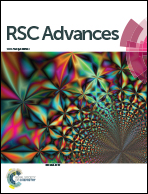Temperature perturbed water structure modification by d(−)-fructose at different concentrations
Abstract
Temperature dependence of water structure modification has been studied at different D(−)-fructose concentrations by near-infrared (NIR) spectroscopy. The temperature susceptibility of different structural components of water with varying hydrogen bond strength in the presence of D(−)-fructose has also been investigated as a function of temperature by 2D correlation spectroscopy from the characteristic spectral variation in water absorption peaks. Apparent molar volume, limiting partial molar volume, free energy change of activation, change in enthalpy of activation and entropy of activation for viscous flow, and other thermodynamic parameters for aqueous solution of D(−)-fructose at different temperatures and concentrations correlate very well with the water structure modification and ordering in the presence of D(−)-fructose inferred from the results of NIR spectroscopy. A comprehensive analysis indicates that the hydrogen bonding capability of the axial and equatorial OH groups in D(−)-fructose varies to a large extent and is mainly responsible for water–fructose interactions with water clusters of different size and geometry such as, dimer, trimer, and cyclic chains at different D(−)-fructose concentrations. D(−)-fructose has been found to act as a water structure-breaker at lower concentrations whereas at higher concentrations it promotes water structure as a structure-maker additive.


 Please wait while we load your content...
Please wait while we load your content...